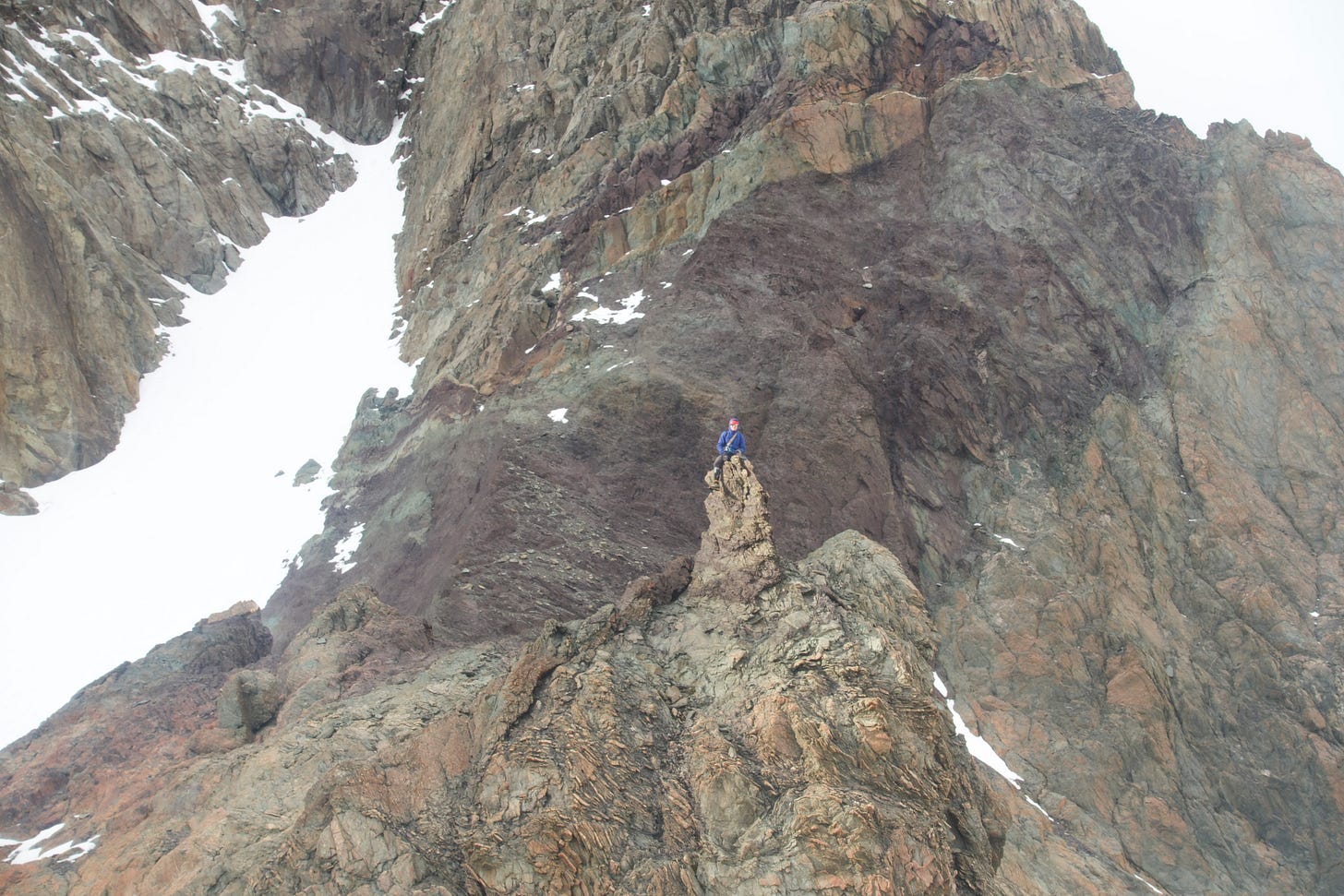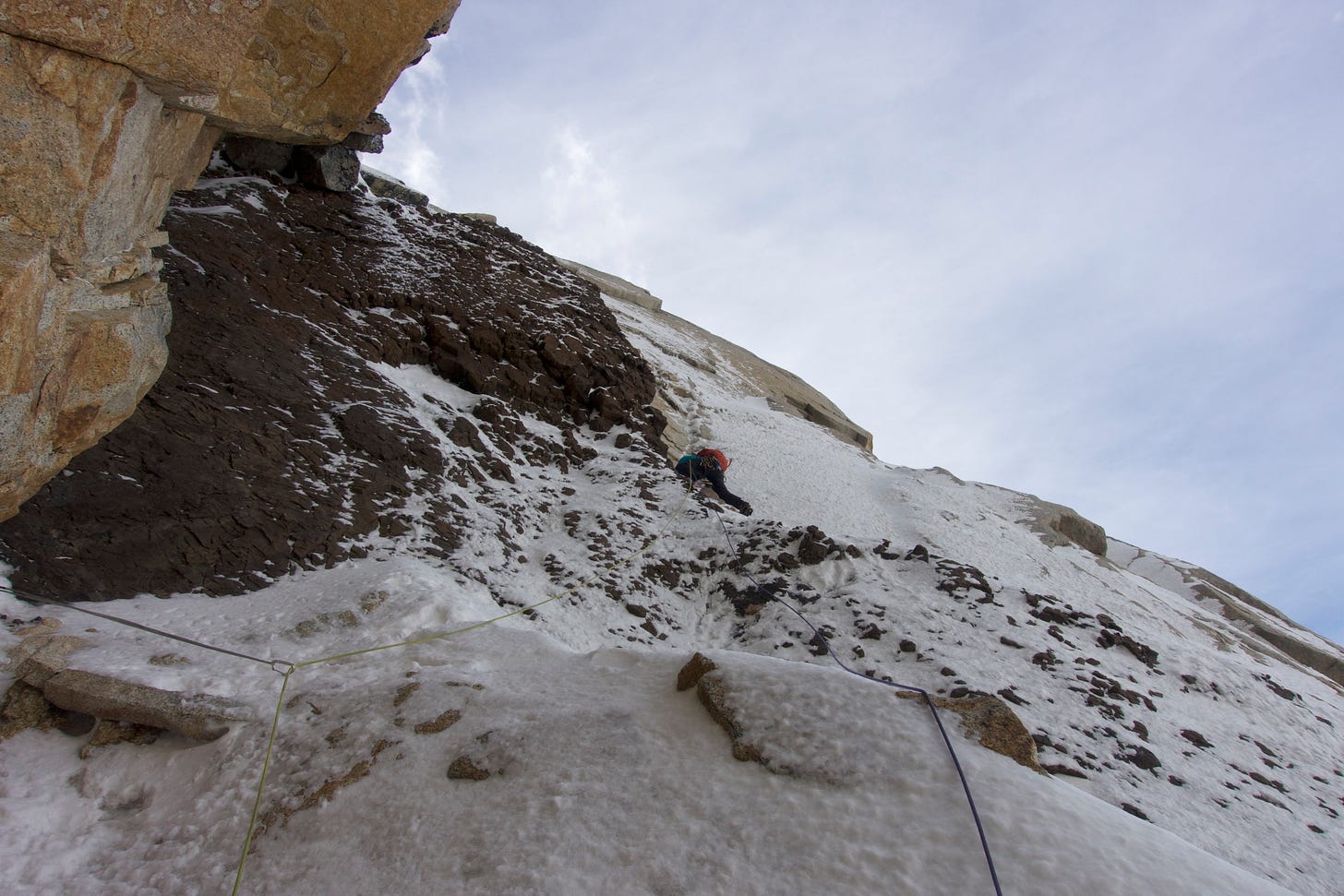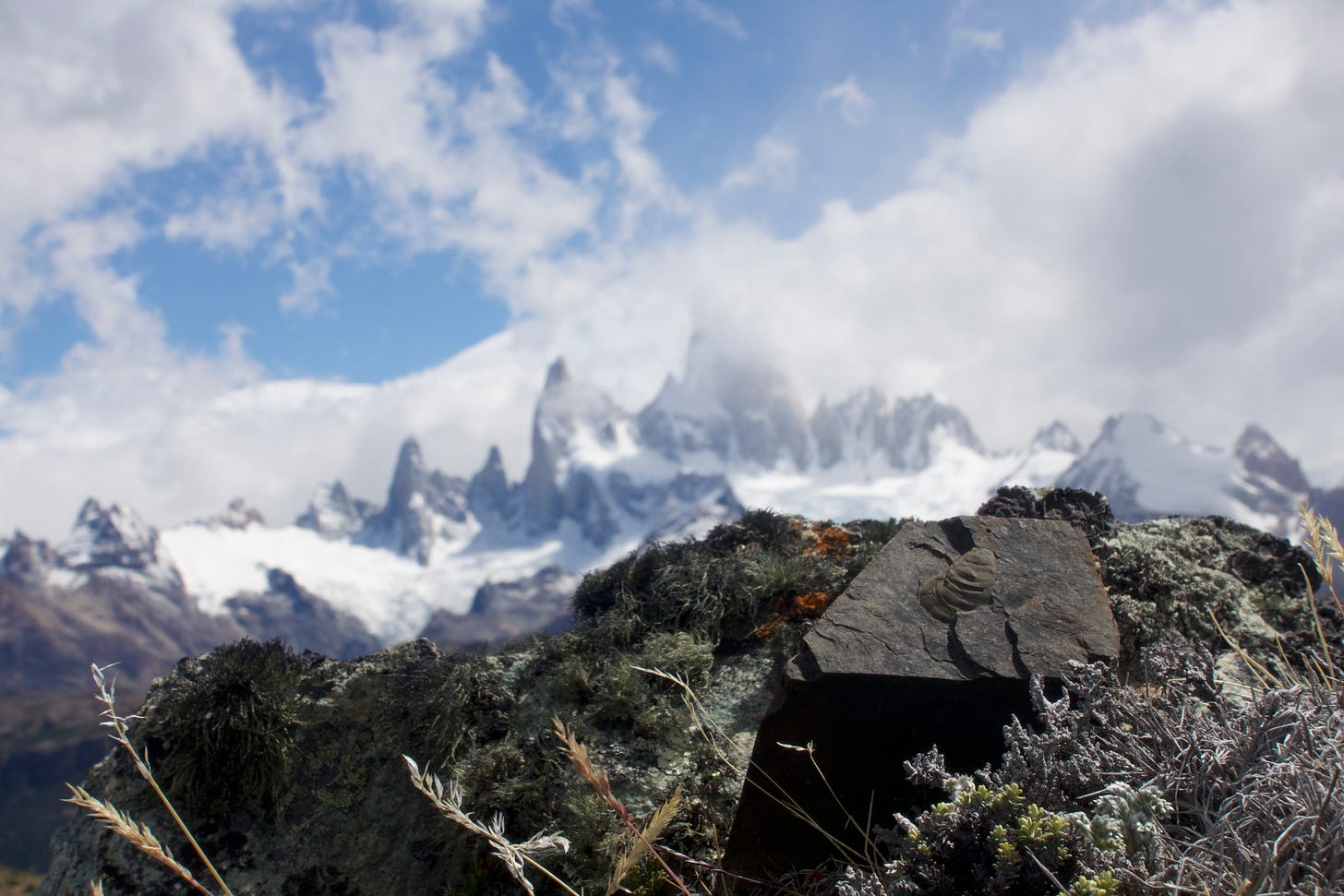This trip was funded, in part, by a ‘Live Your Dream’ grant from the American Alpine Club.
Please describe the climbing project for which support is sought. What is your objective? (60 words): I will travel to Patagonia in mid-December 2016 – January 2017 with Chris of Seattle, WA. We will attempt several routes in the Chalten Massif, with the ultimate goal of summiting both Cerro Torre and Cerro Fitz Roy in our first season in Patagonia.
After discussing it for a long while, Chris and I decided we’d go for the Supercanaleta, though we knew it was a highly popular – perhaps the most popular – objective in the area. It would be our final attempt at climbing in the mountains here, after 42 days. In fact, it was our final attempt on any objective at the end of six months of travel together. Through that time we’d climbed across the Western U.S. and Canada. I’d been elated by good weather, moments where Chris and I were totally in sync, and personal breakthroughs, while I’d been frustrated by bad weather, ‘married life,’ and my reactions to endless travel. Well, we had three more days together, and I wanted to cap it off on the summit of Fitz Roy. That’s what we’d come here to do. That’s what we’d dreamed about. I even said to Chris, “It would be cool to stand on top of that thing.”
We approached and waited out half of the night, then started packing our bags next to a boulder. We were surprised when headlamps shone to our left, then our right – where are these people coming from? – and we shouldered our bags to vie for the start.
We hurried and started climbing second in line, though we knew there was a party high above us. We presumed they were asleep. Over two hours, we climbed great neve for 750 meters. At some point the group up high had started climbing again. When we’d reached a point where the couloir narrowed to two meters wide, the leader pulled a block the size of a microwave off the mountainside.
In unison, Chris and I stopped climbing and listened. We heard it coming. I planted my tools into the hard snow, sat down against the tethers that bound me to them and prostrated myself before a ‘whizZZ‘ from above.
Oh God. Oh God. I’m an atheist.
I screamed ‘rock’ twice, lengthening the O’s.
“ROOOOCK!”
Sweat, hot on my face, felt cold when I pressed it to the snow.
“ROOOOCK!”
The boulder exploded immediately above, and sparks and the acrid scent of rockfall whooshed around and past us.
“Are you OK?”
“Yes. Are you?”
“Yes. Let’s get the fuck out of here.”
We bailed until dawn, and spent a while back under our boulder sipping hot drinks. Hours later, as the sun crested over the bulk of Fitz Roy, we stepped off the glacier, and spent a few hours napping on sunny rocks at the edge of a lake.
Forty-two days earlier, we drove towards El Chalten. We watched a wall of clouds advance from the west, engulfing Cerro Torre. When we arrived, an hour later, Fitz Roy was obscured as well.
At the outset we declared we’d be ready to ‘stick our noses in it’ and climb sheltered objectives in marginal weather. The first day we decided to venture into the mountains – a week after we arrived – we made plans to establish a cache of gear on the Torre glacier and go climbing if the weather improved. We were blown around the glacier by gusty winds – our notions of ‘marginal weather’ shifted from romantic to realistic. So like every hungry Patagonian climber, we sat in our hostel and watched the forecasts closely, trying to determine when we’d have good-enough weather to go into the mountains.
Our first opening in the weather came a few days before Christmas, when our friend Austin had joined us. We decided to return to the Torre valley and attempt a few climbs. The day we arrived we walked up to El Mocho, a small sub peak of Cerro Torre that hosts some low-elevation ice climbs. We discovered that all of the ice routes on that mountain were out of condition. We returned to camp and rested the following day, and launched early on our third morning for an attempt on Cerro Stanhardt via the route ‘Exocet,’ an objective much higher than those on El Mocho.
We arrived at the start of the climb on a cloudy, windless day – novel calm – and Chris did a fine job leading us through the first several pitches, along granite weaknesses plastered with rime ice. As we climbed the clouds threatened to break, and Austin grew agitated, repeating “This mountain is about to come alive! We’ve GOT to hurry up!” I stared up at the rime-covered walls through the lessening clouds. It looked like the mountain was freezer-burned. Gulp.
We continued along snow slopes and rime started to trickle down the face. We did a short rappel to reach another snowfield. Rime was now pouring down. We were almost to the base of the chimney that leads to the upper mountain when Chris stopped around a corner. Austin and I were tucked under an overhang. The rope started to come slack, and I heard him yell, ‘I’m coming back!’
I reeled him back in. We sat in our protected nook for a few hours on Christmas day, relaxing and thinking of our families back home. Holiday cheer flowed from the speaker on my phone.
Feliz Navidad / Feliz Navidad / Feliz Navidad / Prospero Ano why Felicidad / We wanna wish you a Merry Christmas / We wanna wish you a Merry Christmas / We wanna wish you a Merry Christmas / From the bottom of our heart
As the sun disappeared the rime showers subsided. We continued around the corner to the base of the chimney. A team had been here a week before and found this section out of condition – they were Italians, which explains why Austin and Chris looked very confused after I looked into the chimney, saw great ice, and yelled back; “I dunno what the Ruskies were talking about, but this ice is FAT!”
I led three pitches up the chimney. At the top of the third pitch, just before the end of the difficulties, we reached our cut-off time. Five minutes after we started down, the wind picked up and a spindrift waterfall began to pour down the chimney. We rappelled until dawn, reached the glacier cold and tired, and trudged back to basecamp. Twenty-six hours after leaving, we got back into our sleeping bags.
A few days of rest followed, and just before the New Year, Austin, Chris and I decided to try the North Ridge of Cerro Solo. We approached in the evening and slept at the forest’s edge, protected from the wind by the friendly, flexy branches of the lenga trees about us.
We woke to an early alarm, had a quick bite, approached the base of the ridge in the morning twilight, and began climbing after sunrise.
I’ve spent a lot of time walking and climbing around on snow and ice, and climbing on clean rock, but I’ve never spent much time on bad rock by choice. Austin and Chris, on the other hand, are pedigreed Cascadian chossdogs. So, as I tiptoed ever so gently along the ridge, they bounded ahead sniffing out the least-bad way through variegated bands of metamorphic crap-rock the likes of which I’d never touched before.
We scrambled along the ridge, up the first tower, and made a rappel to the base of the second. We climbed and rappelled the second tower, soloed the third tower, and did several more rappels to a notch dubbed ‘Puff Puff Pass’ (the start of ‘El Dragon’). From here, Austin led as we simulclimbed -and belayed one pitch – to the summit of Cerro Solo. We reached the summit in the early evening and descended to our packs just before the sun went down.
Now that we’d tasted success on a humble Patagonian summit, Chris and I were hungry to return to Exocet. We stared at poor weather forecasts and rationalized plans to get it done in ever more marginal conditions, until we realized we should have a plan B. Yet our general plan A was to approach the climb with a light bivy kit and continue up as the weather allowed.
We put plan A into motion during the next clearing window. At the snowline under Cerro Stanhardt, we decided we’d wait out the winds. So we dug an alcove in a wind-shaped snowbank and spent two hours cuddling under a tarp. While this was very cozy, Plan B began to look pur’dy good.
We returned to our basecamp and prepared for the more moderate – but still excellent – ‘Super Domo.’ The following day we approached and did the climb – a few easy mixed pitches to one tricky mixed pitch topped off by three beautiful pitches of ice. When I started up the final pitch, clouds began to waft overhead. As I crested the last of the ice, thirty minutes later, a squall punched me in the face.
Once again we rappelled through whiteout. We slogged back down the glacier, which had baked in the sun for the entire day, looking for traces of our filled-in tracks. Chris punched through a bridge to his waist, so we roped up. We continued slowly after that, testing for cracks, and in total the descent took about one and a half times longer than the approach. We got back to our tent without enough time to return to town in the light, so we enjoyed a hearty one-bar dinner and spent the night.
El Chalten is a tourist town nestled in a valley hemmed in by bluffs. We spent a lot of time in town because of the weather in the mountains. Looking back, I find it funny to think that on my first trip outside North America, I spent the majority of my time living in a very windy hole full of tiny houses and very friendly people. There were lots of opportunities to practice Spanish, make new friends, eat ice cream, and go climbing on nearby crags, yet there were moments where cabin-fever set in and town started to feel very small.
At one such moment I started running, aiming for the closest prominent point I could see from the clifftop north of town. After a few kilometers, I’d gotten high enough to find some proper wind – it’s never far off – and soon running turned to hiking, to walking, and finally, to leaning. I tucked behind a slate outcrop for respite. While I enjoyed a snack and drummed up the courage to poke my head into the wind again, I noticed a mollusk in the outcrop in front of me. I abandoned my high point for the prospect of finding more clams. Thirty minutes later I’d made no significant discoveries. On my way back to town, I wondered – was I a lucky paleontologist that found one unlucky clam, or an unlucky paleontologist that found one lucky clam?
On Day 42, before we followed our ambition into the choke of the Supercanaleta, Chris and I waited out the cold of the night sitting on our packs, wrapped in a single sleeping bag, passing a liter bottle of hot tea back and forth. We talked about climbing for fifteen, maybe twenty minutes. And then we spoke of the things foremost on our minds – what life had brought us, what life would bring us, love, and possibility. All the while, we stared up at the brightest twinkling stars I’d ever seen, through the clear of a cloudless night.










